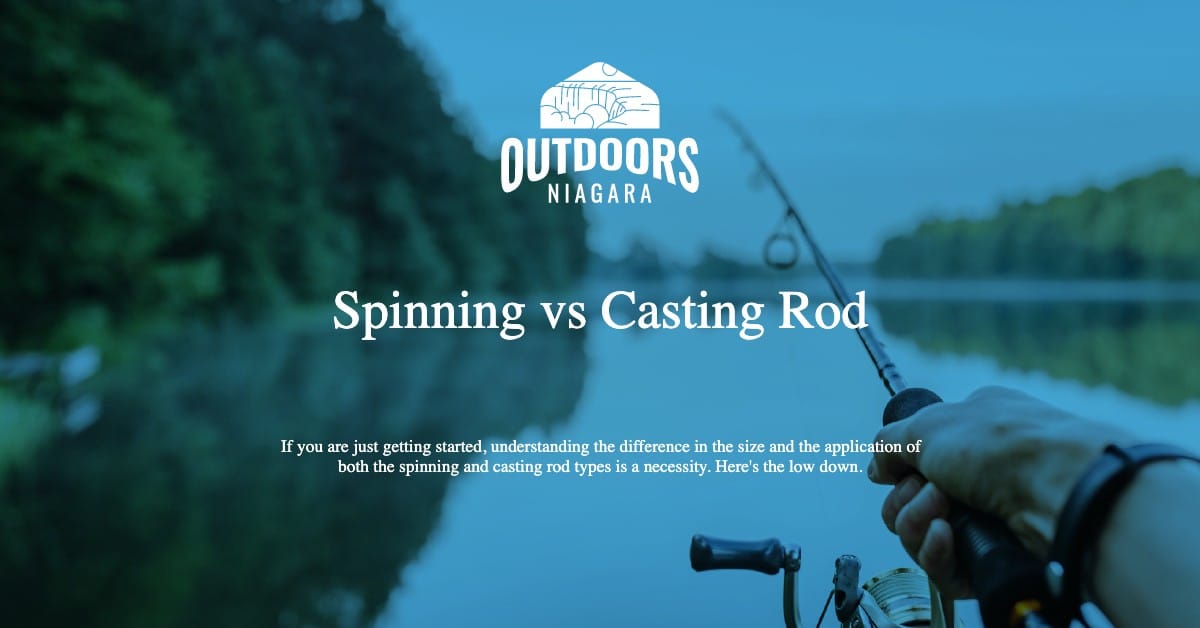Similar to golf equipment, your fishing tools should be versatile.
With that in mind, we always recommend that people invest in both a spinning and a casting rod if they want to get the best results and the most amount of fish trophies.
If you are just getting started, understanding the difference in the size and the application of both the spinning and casting rod types is a necessity.
To help you, we have created a guide explaining the basics, showcasing casting tips, and summarizing the differences/similarities between spinning and baitcasting rods.
Let’s get started!
Contents
Basic Info About Spinning Rods
Spinning rods are great for surface fishing and are suitable for using lightweight lures.
These have the reel positioned on the bottom of the rod, whereas baitcasting rods have the reel fixed on the top.
They are, however, constructed of robust materials like fiberglass, carbon fiber, or conventional graphite.
Spinning rods are great for fishing with live bait or trolling and are commonly used to capture catfish, panfish, and walleye.
The stress against the guide is greater since the reel is near the bottom of the rod. This is why spinning rods aren’t ideal for larger fish, as the line might break or detach from the guide while reeling in a huge fish.
Because the reel handle is at the bottom of the rod, the line guides are at the bottom of the pole as well, on the same side as the reel.
In contrast to its line guides, a spinning rod’s backbone (or spine) runs along the top of the pole.
The section of a fishing rod that is stronger and better prepared to bear the strain when the pole is bent by a large fish is called the spine.
It’s always on the blank’s side that faces away from the fish.
What Is a Spinning Rod Mostly Used for?
Spinning rods are available in a variety of lengths and sizes, ranging from ultralight graphite poles to hefty fiberglass boat rods.
Spinning poles are the most versatile fishing rods used by fishermen and can be modified for practically any type of game fishing due to their wide range of design and size (apart from fly fishing).
These are most commonly used for lure casting and retrieval, but they may also be used for bottom fishing, bobber fishing, live lining, trolling, boat fishing, all-around inshore fishing, bait fishing, ice fishing, and surf fishing.
Although there is a lot of overlap between the two, spinning poles are utilized for light action applications.
Basic Info About Casting Rods
Before we further discuss the difference between casting and spinning rods, you should be aware that fishing rod setups are made to match the exact sort of fishing reels.
Spinning rods must be linked to spinning reels while casting rods are designed to be used with a low-profile casting reel.
When you combine a casting rod and a spinning reel, your entire fishing experience can be a disaster.
With that in mind, make sure to invest extra time in pairing your rod and reel.
Casting rods, often known as baitcasting rods, are fishing rods with improved angling accuracy and the ability to handle heavier lures.
The baitcasting setup is usually constructed of graphite, fiberglass, or carbon fiber, making them strong and light.
On top of the rod is also the baitcasting reel. This improves power and accuracy, allowing you to bait cast at longer distances with more precision.
Casting poles come in a range of lengths and sizes, similar to spinning rods, and are used for a variety of fishing purposes.
Casting rods, on the other hand, are more commonly employed for heavy-duty purposes than spinning poles.
The pole backbone and line guides are likewise situated running along the top of the rod, with the reel handle pointing upwards on top of the rod handle.
Because the reel and fishing line is on top of the rod, larger fish tend to pull away by bending the pole down.
When utilizing heavier lures or reeling in larger fish like bass and trout, this gives you greater control.
Keep in mind that casting rods are harder to maneuver and thus recommended to more experienced fishermen.
What Is a Casting Rod Mostly Used for?
Casting rods are most often used for casting and retrieving artificial lures in freshwater angling and are loved by a majority of bass fishing enthusiasts.
Similarities of Spinning and Casting Rods
Prior to discussing the differences, we want to explain a few similarities that you will find between the type of fishing rod that is spinning and casting.
Feature Ergonomic and Durable Handles
Cork is used for most rod handles because it provides a firmer grip and is more responsive to the hand.
They can, however, be built out of EVA foam, which is lighter, more durable, and requires less care.
You Can Control Action (Slow, Medium, Fast)
Slow-action rods can curve downward to all of their extents, but moderate rod actions allow them to bend until the middle.
Thus, fast-action rods only arch at the top of the rod.
Come in a Wide Variety of Lengths/Sizes
Casting rods, like spinning rods, are typically four to fourteen feet long.
Experienced anglers, on the other hand, prefer rods that are six to eight feet long.
Differences Between Spinning and Casting Rods
While you may find a few similarities using spinning and casting rods, it is a fact that these have different applications and require a diverse skill level.
Guide Size and Position
One of the main differences is in the guide sizes.
Spinning rods feature good guides and a wide space between them.
On the other hand, casting rods have smaller guides than spinning rods, and their spacing is also narrower.
Casting rod line guides are tiny over the whole length of the rod, but line guides on spinning poles near the handle are significantly larger than those towards the tip.
The broad shape fits the large diameter of a spinning reel’s line spool.
Furthermore, the line guides on spinning rods protrude further from the backbone of the pole than those on casting poles, which are nearer to the rod.
Also, casting rods have a higher number of line guides compared to spinning rods.
A spinning reel’s line guides go along the bottom of the pole, whereas a casting pole’s guides run along the top, allowing more accurate casting.
The line guides are on the same side of the pole as the reel seat in each case.
Reel Seat Orientation
The fact that spinning rods aren’t suitable for heavyweight fishing impairs the benefits of spinning reels.
Casting reels have powerful line twists and can thus carry a lot of weight.
When opposed to casting rods, spinning rods are positioned upside down.
A casting pole’s reel seat is meant to retain a baitcasting reel facing upwards on top of the reel handles, whereas a spinning pole’s reel seat is designed to hold a spinning reel pointing downwards.
Experience and Cost
Casting rods are difficult to use due to the way the rod bends as the eyelets move upward.
They are unique and tough to use for new users. Spinning rods, on the other hand, are simple to operate and may be picked up quickly by beginners.
It is simple to fish with them, and the experience is pleasurable.
Learning to use a casting rod is more expensive than learning to use a spinning rod.
Trying to get the hang of a casting rod will include changing lines numerous times.
Not only is this time-consuming, but it is also costly. On the other hand, spinning rods do not necessitate any further expenses aside from the initial purchase price.
Application
When compared to spinning rods, casting rods tend to perform better.
Both are good, but casting rods are more commonly used by serious anglers, while novice anglers may use spinning rods.
Trolling, still, and jig fishing are the most common uses for spinning rods.
Anglers have learned that casting rods have few characteristics, allowing them to be used under heavy cover.
Spinning rods can only be used for trolling and still fishing; thus, they can’t be used for thick cover.
FAQs
When to Use a Spinning/Casting Rod?
Surfcasting for saltwater fish or steelhead and salmon fishing requires long heavy action rods with expanded grips for two-handed casting.
Trolling or fishing with live bait for catfish, panfish, and walleye is also popular with spinning rods.
When it comes to a casting rod, you are best off using it when in for a session of heavy fishing and when the technique requires a long casting distance.
What Are the Pros and Cons of Spinning/Casting Rods?
Spinning rods are extremely adaptable and may be used for nearly any type of fishing.
In addition to that, they are great for lightweight applications and are easier to master.
Still, they are not as great for casting larger lures and fishing tuna, marlin, etc.
On the other hand, casting rods offer more casting accuracy long-distance and are more suitable for heavy-duty applications.
Also, it is easier to create a baitcasting combo for heavier fish using a casting rod.
However, these are more expensive and require a higher skill level.
What is a Casting Rod Used for?
In freshwater angling, casting rods are most commonly used for casting and retrieving light lures, and the majority of bass fishermen do so.
You should also use it if you plan on doing a lot of heavyweight fishing and the technique needs a lengthy casting distance.
Which is Better, Casting or a Spinning Reel?
It all depends on whether you are going lightweight or heavyweight fishing. In the latter scenario, a casting rod should be your choice.
Can I Use Spinning Rod as a Casting Rod?
No. The spinning gear, number of guidelines, and reel orientation of a spinning rod don’t fit a purpose of a casting rod.
Wrap Up
In the end, it comes down to your personal preference.
A spinning rod is a perfect pick if you are just starting and want to go lightweight fishing.
On the other hand, those with more casting experience and enthusiasm for heavy-duty fishing in freshwaters will enjoy casting rods.







